In Vitro Analysis of the Tribological Behaviour of Different Material Combinations for Telescopic Crowns
Abstract
:1. Introduction
- The choice of the material combination for primary and secondary crown affects the pull-off forces at the beginning of the period of use.
- At the beginning of the period of use, pull-off forces for combinations of different groups of materials are smaller compared to combinations of similar or identical groups.
- Combinations of similar or identical groups of materials show a higher long-term reduction of retentive forces compared to combinations of different groups.
- Pull off forces are influenced by the secondary crowns’ manufacturing technology—the variability of pull-off forces is smaller for electroformed secondary crowns compared to casted ones.
- Wear-associated surface roughness on primary crowns’ surfaces are larger for combinations of similar or identical groups of materials compared to combinations of different groups.
2. Experimental Section
2.1. Materials
2.2. Manufacturing of the Specimens
2.3. Testing Procedures
2.4. Data Collection
2.5. Statistics
3. Results
3.1. Pull-Off Forces
3.2. Surface Roughness
3.3. SEM and EDX Analyses
4. Discussion
4.1. Methodical Limitations
4.2. Influence of Material Combinations
4.3. Influence of Manufacturing Technologies
4.4. Surface Roughness
5. Conclusions
Acknowledgments
Author Contributions
Conflicts of Interests
References
- Öwall, B.; Bieniek, K.W.; Spiekermann, H. Removable partial denture production in western Germany. Quintessence Int. 1995, 26, 621–627. [Google Scholar] [PubMed]
- Bergman, B.; Ericson, A.; Molin, M. Long-term clinical results after treatment with conical crown-retained dentures. Int. J. Prosthodont. 1996, 9, 533–538. [Google Scholar] [PubMed]
- Igarashi, Y.; Goto, T. Ten-year follow-up study of conical-crown-retained dentures. Int. J. Prosthodont. 1997, 10, 149–155. [Google Scholar] [PubMed]
- Minagi, S.; Natsuak, N.; Nishigawa, G.; Sato, T. New telescopic crown design for removable partial dentures. J. Prosthet. Dent. 1999, 81, 684–688. [Google Scholar] [CrossRef]
- Wenz, H.J.; Hertrampf, K.; Lehmann, K.M. Clinical longecity of removable partial dentures retained by telescopic crowns: Outcome of the double crown with clearance fit. Int. J. Prosthodont. 2001, 14, 207–213. [Google Scholar] [PubMed]
- Hoffmann, O.; Beaumont, C.; Tatakis, T.N.; Zafiropoulos, G.G. Telescopic crowns as attachments for implant supported restaurations. J. Oral Implantol. 2006, 32, 291–299. [Google Scholar] [CrossRef] [PubMed]
- Wöstmann, B.; Balkenhol, M.; Weber, A.; Ferger, P.; Rehmann, P. Long-term analysis of telescopic crown retained removable partial dentures: Survival and need for maintenance. J. Dent. 2007, 35, 939–945. [Google Scholar] [CrossRef] [PubMed]
- Grossmann, A.C.; Hassel, A.J.; Schilling, O.; Lehmann, F.; Koob, A.; Rammelsberg, P. Treatment with double crown-retained removable partial dentures and oral health—Related quality of life in middle-and high-aged patients. Int. J. Prosthodont. 2007, 20, 576–578. [Google Scholar] [PubMed]
- Wöstmann, B.; Balkenhol, M.; Kothe, A.; Ferger, P. Dental impact on daily living of telescop crown-retained partial dentures. Int. J. Prosthodont. 2008, 21, 419–421. [Google Scholar] [PubMed]
- Krennmair, G.; Seemann, R.; Weinländer, M.; Piehslinger, E. Comparison of ball and telescopic crown attachments in implant-retained mandibular overdentures: A 5-year prospective study. Int. J. Oral Maxillofac. Implants 2011, 26, 598–606. [Google Scholar] [PubMed]
- Akagawa, Y.; Seo, T.; Ohkawa, S.; Tsuru, H. A new telescopic crown system using a soldered horizontal pin for removable partial dentures. J. Prosthet. Dent. 1993, 69, 228–231. [Google Scholar] [CrossRef]
- Bayer, S.; Stark, H.; Gölz, L.; Keilig, L.; Kraus, D.; Hansen, A.; Enkling, N. Clinical retention force development of double crowns. Clin. Oral Investig. 2012, 16, 407–411. [Google Scholar] [CrossRef] [PubMed]
- Höland, W.; Schweiger, M.; Frank, M.; Rheinberger, V. A comparison of the microstructure and properties of the IPS Empress 2 and IPS Empress Glass-Ceramics. J. Biomed. Mater. Res. 2000, 53, 297–303. [Google Scholar] [CrossRef]
- Pietruski, J.K.; Sajewicz, E.; Sudnik, J.; Pietruska, M.D. Retention force assessment in conical crowns in different material combinations. Acta Bioeng. Biomech. 2013, 15, 35–42. [Google Scholar] [PubMed]
- Besimo, C.; Graber, G.; Flühler, M. Retention forces changes in implant-supported titanium telescope crowns over long-term use in vitro. J. Oral. Rehabil. 1996, 23, 372–378. [Google Scholar] [CrossRef] [PubMed]
- Ohkawa, S.; Okane, H.; Nagasawa, T.; Tsuru, H. Changes in retention of various telescope crown assemblies over long-term use. J. Prosthet. Dent. 1990, 64, 153–158. [Google Scholar] [CrossRef]
- Frechette, A.R. The influence of partial denture design on distribution of force to abutment teeth. J. Prosthet. Dent. 2001, 85, 527–539. [Google Scholar] [CrossRef] [PubMed]
- Bayer, S.; Stark, H.; Mues, S.; Keilig, L.; Schrader, A.; Enkling, N. Retention force measurement of telescopic crowns. Clin. Oral Investig. 2010, 14, 607–611. [Google Scholar] [CrossRef] [PubMed]
- Bayer, S.; Stark, H.; Gölz, L.; Keilig, L.; Kraus, D.; Hansen, A.; Enkling, N. Telescopic crowns: Extra-oral and intra-oral retention force measurement—In vitro/in vivo correlation. Gerodontology 2012, 29, 340–347. [Google Scholar] [CrossRef] [PubMed]
- Behr, M.; Hofmann, E.; Rosentritt, M.; Lang, R.; Handel, G. Technical failure rates of double crown-retained removable partial dentures. Clin. Oral Investig. 2000, 4, 87–90. [Google Scholar] [CrossRef]
- Stober, T.; Bermejo, J.L.; Seche, A.C.; Lehmann, F.; Rammelsberg, P.; Bömicke, W. Electroplated and cast double crown-retained removable dental prostheses: 6-year results from a randomized clinical trial. Clin. Oral Investig. 2015, 19, 1129–1136. [Google Scholar] [CrossRef] [PubMed]
- Stancic, I.; Jelenkovic, A. Retention of telescopic denture in elderly patients with maximum partially edentulous arch. Gerodontology 2008, 25, 162–167. [Google Scholar] [CrossRef] [PubMed]
- Turp, I.; Bozdag, E.; Sünbüloglu, E.; Kahruman, C.; Yusufoglu, I.; Bayraktar, G. Retention and surface changes of zirconia primary crowns with secondary crowns of different materials. Clin. Oral Investig. 2014, 18, 2023–2035. [Google Scholar] [CrossRef] [PubMed]
- Faber, J.F.; Huber, C. Electroformed telescope crowns—A hydraulic system. J. Dent. Res. 2001, 80, 551. [Google Scholar]
- Weigl, P.; Lauer, H.C. Advanced biomaterials used for a new telescopic retainer for removable dentures: Ceramic vs. electroplated gold copings: Part II. Clinical effects. J. Biomed. Mater. Res. 2000, 53, 337–347. [Google Scholar] [CrossRef]
- Gebelein, M.; Richter, G.; Range, U.; Reitemeier, B. Dimensional changes of one-piece frameworks cast from titanium, base metal, or noble metal alloys and supported on telescopic crowns. J. Prosthet. Dent. 2003, 89, 2–7. [Google Scholar] [CrossRef] [PubMed]
- Greven, B.; Luepke, M.; Dorsche, S.H. Telescoping implant prostheses with intraoral luted galvano mesostructures to improve passive fit. J. Prosthet. Dent. 2007, 98, 239–244. [Google Scholar] [CrossRef]
- Höhnel, U.; Reitemeier, B.; Richter, G. Zur Vergießbarkeit von Titan unterschiedlichen Reinheitsgrades. Dent. Labor 1996, 44, 421–423. [Google Scholar]
- Groche, P.; Nitzsche, G. Temperatureinfluss auf den Adhäsionsverschleiß beim Umformen von Aluminiumblechen. Mater. Werkst. 2004, 35, 461–466. [Google Scholar] [CrossRef]
- Kragelski, I.W. Reibung und Verschleiß; Carl Hanser Verlag: München, Germany, 1971. [Google Scholar]
- Rößler, J.; Göbel, R.; Welker, D. Der Haftmechanismus von Galvano—Doppelkronen. ZWR 2005, 114, 437–442. [Google Scholar] [CrossRef]
- Sakai, Y.; Takahashi, H.; Iwasaki, N.; Igarashi, Y. Effects of surface roughness and tapered angle of cone crown telescopic system on retentive force. Dent. Mater. J. 2011, 30, 635–641. [Google Scholar] [CrossRef] [PubMed]
- Enghardt, S.; Richter, G.; Richter, E.; Reitemeier, B.; Walter, M. Experimental investigations on the influence of adhesive oxides on the metal-ceramic bond. Metals 2015, 5, 119–130. [Google Scholar] [CrossRef]
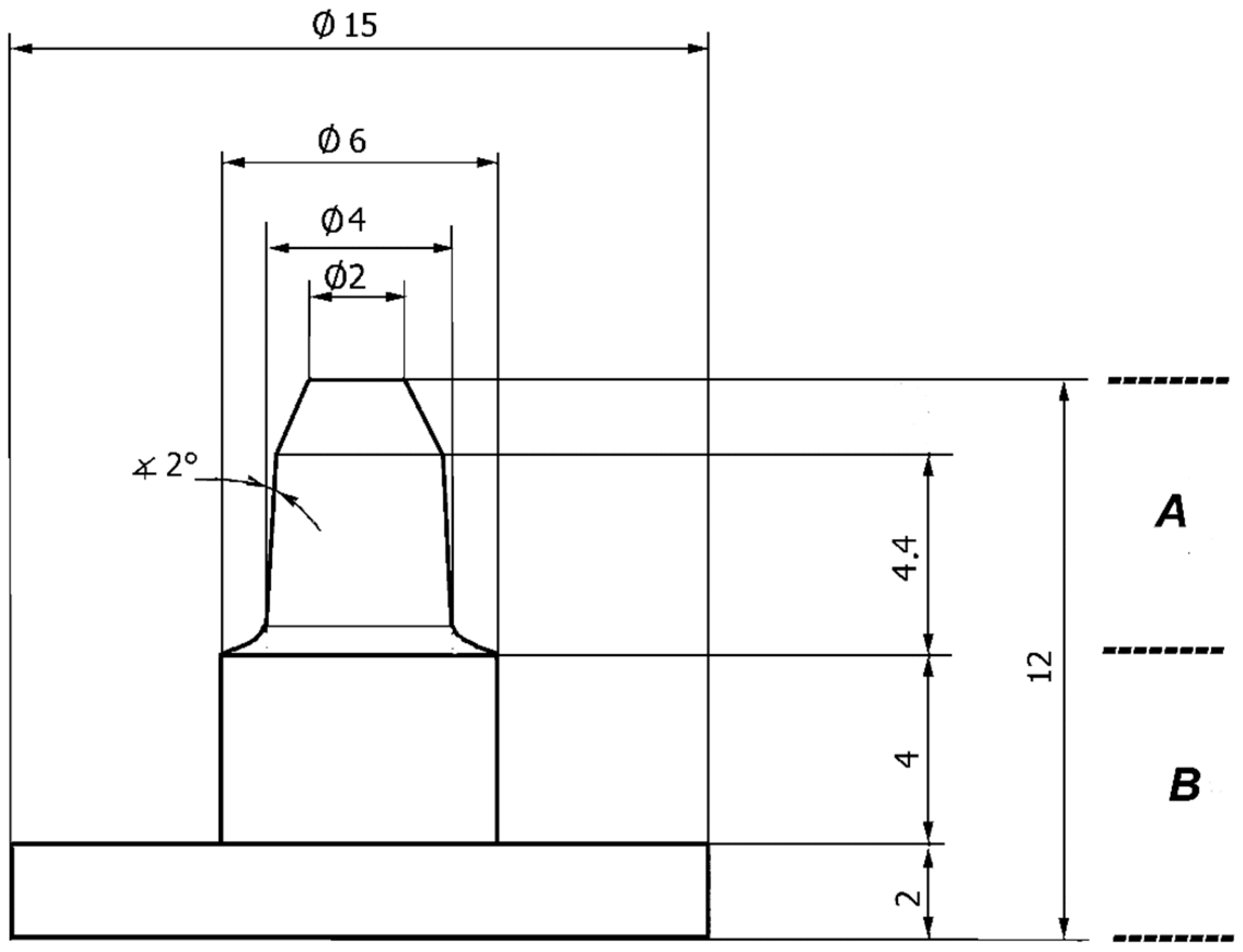
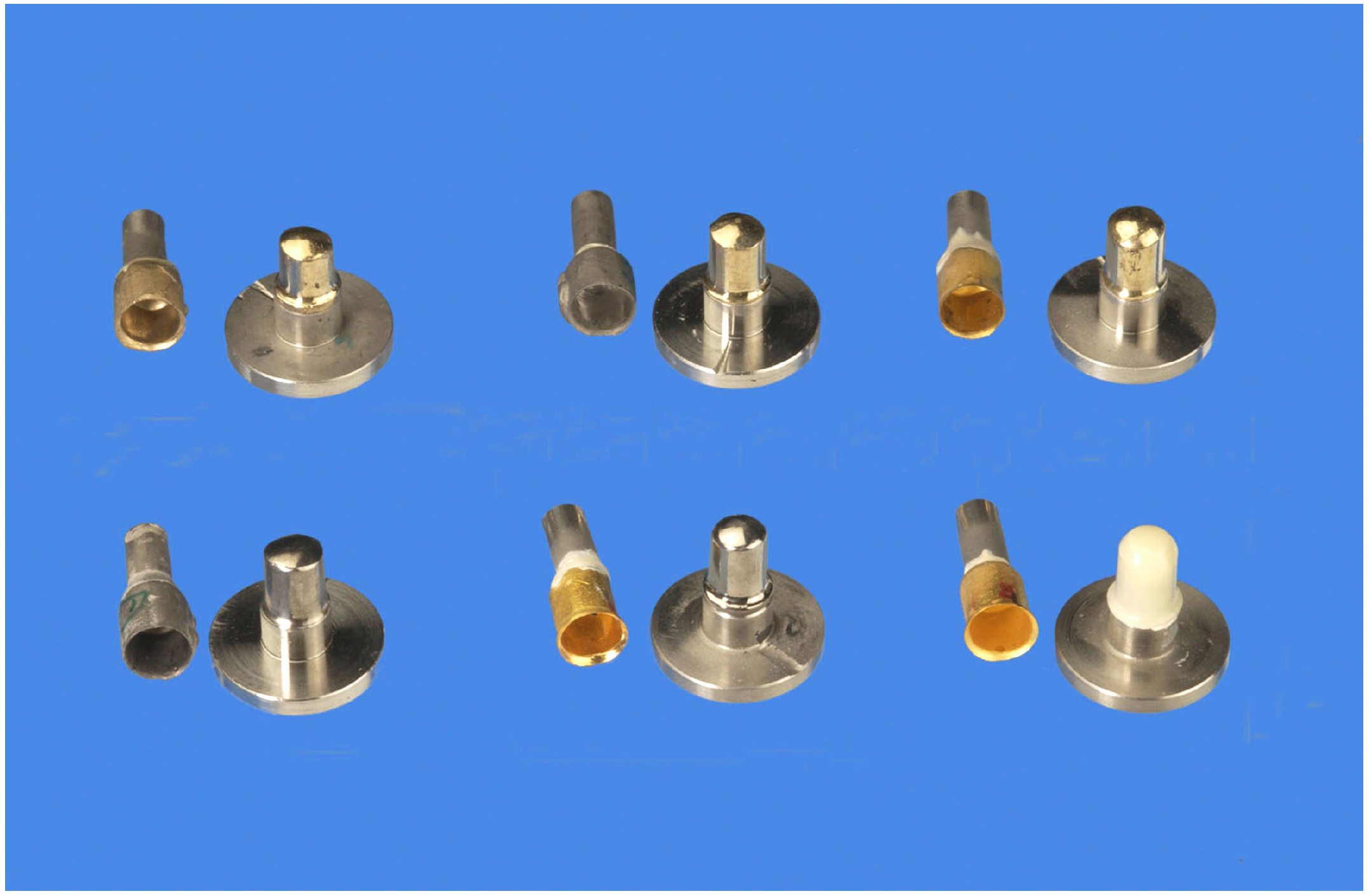
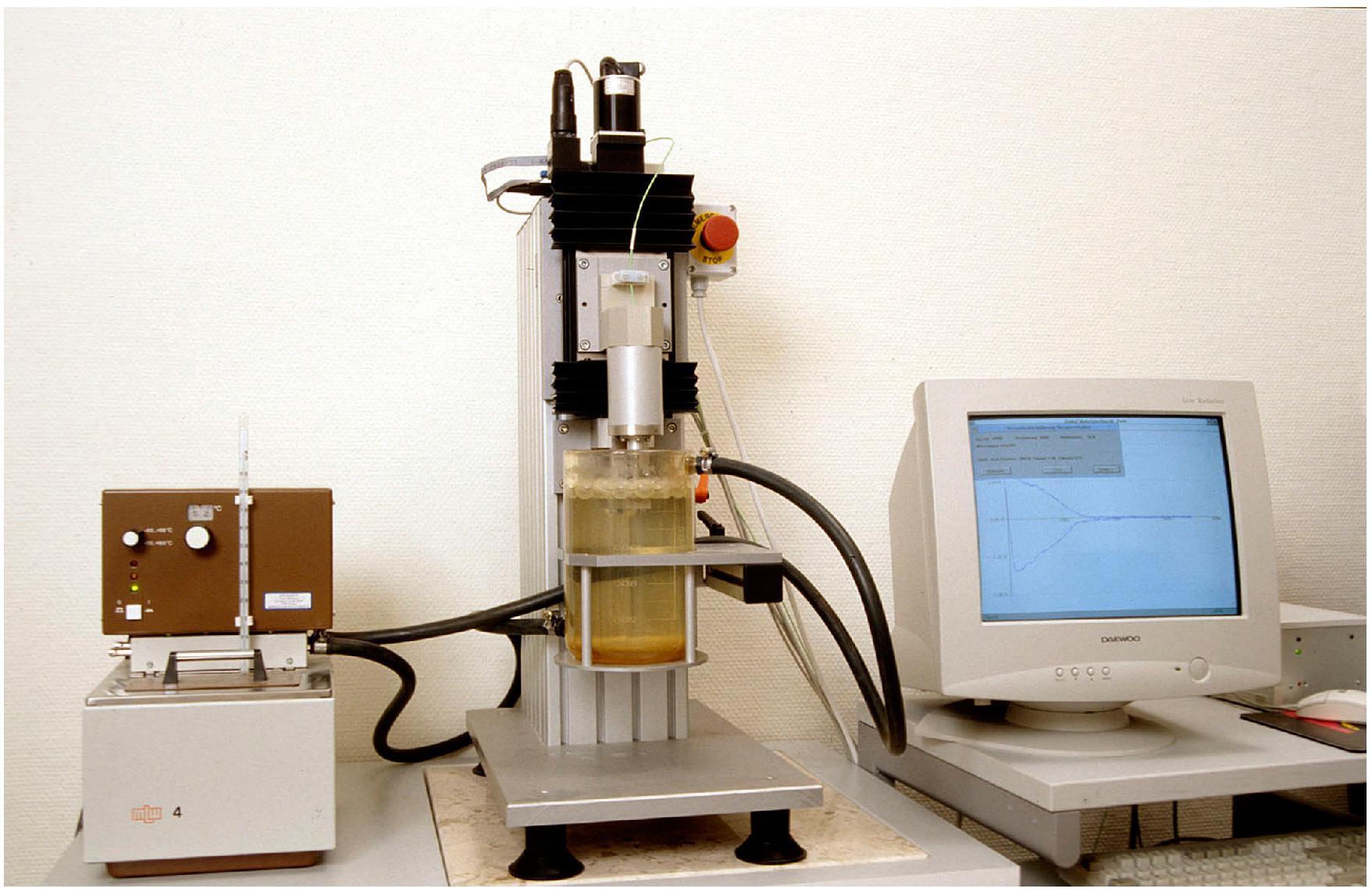
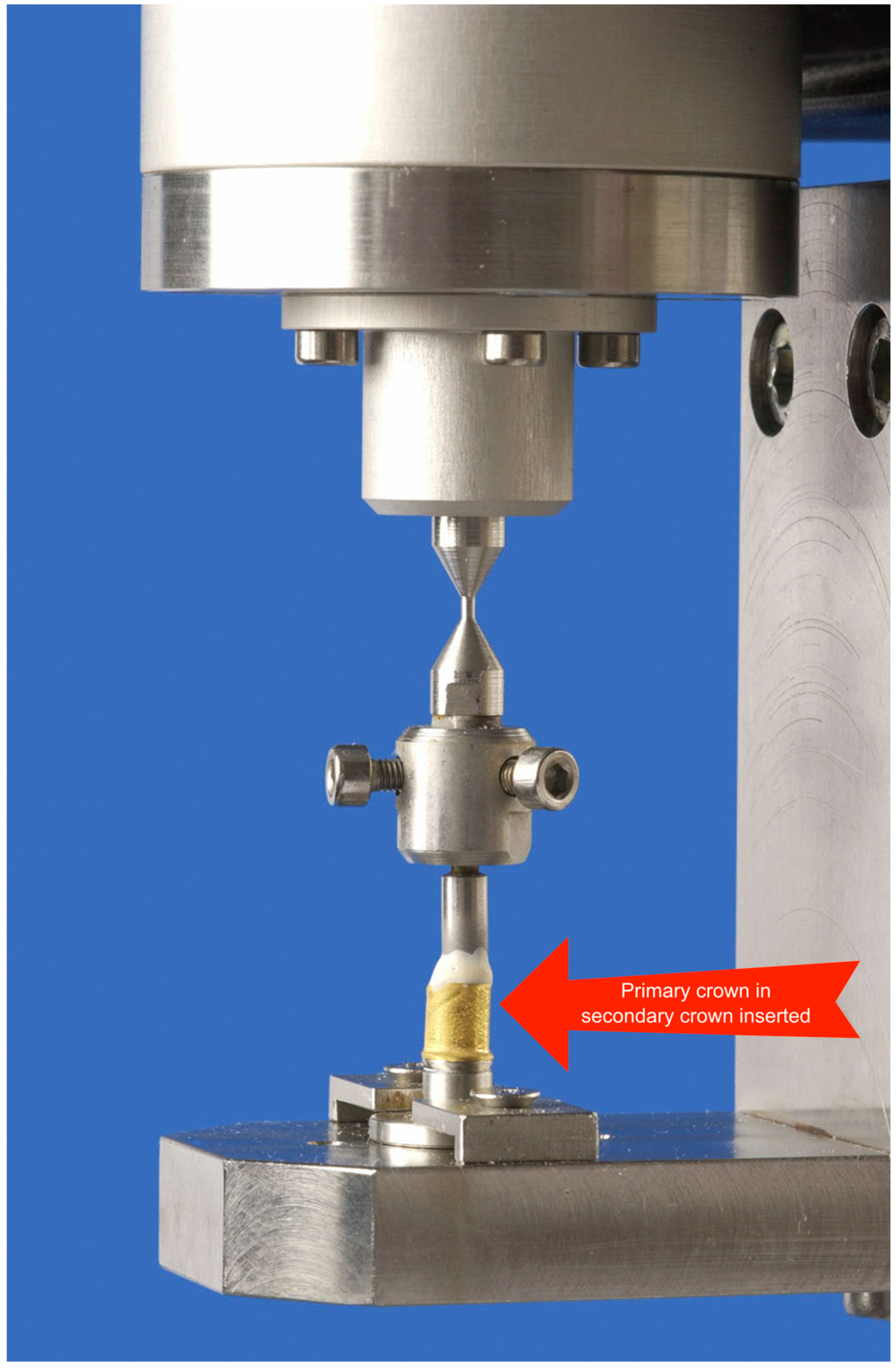

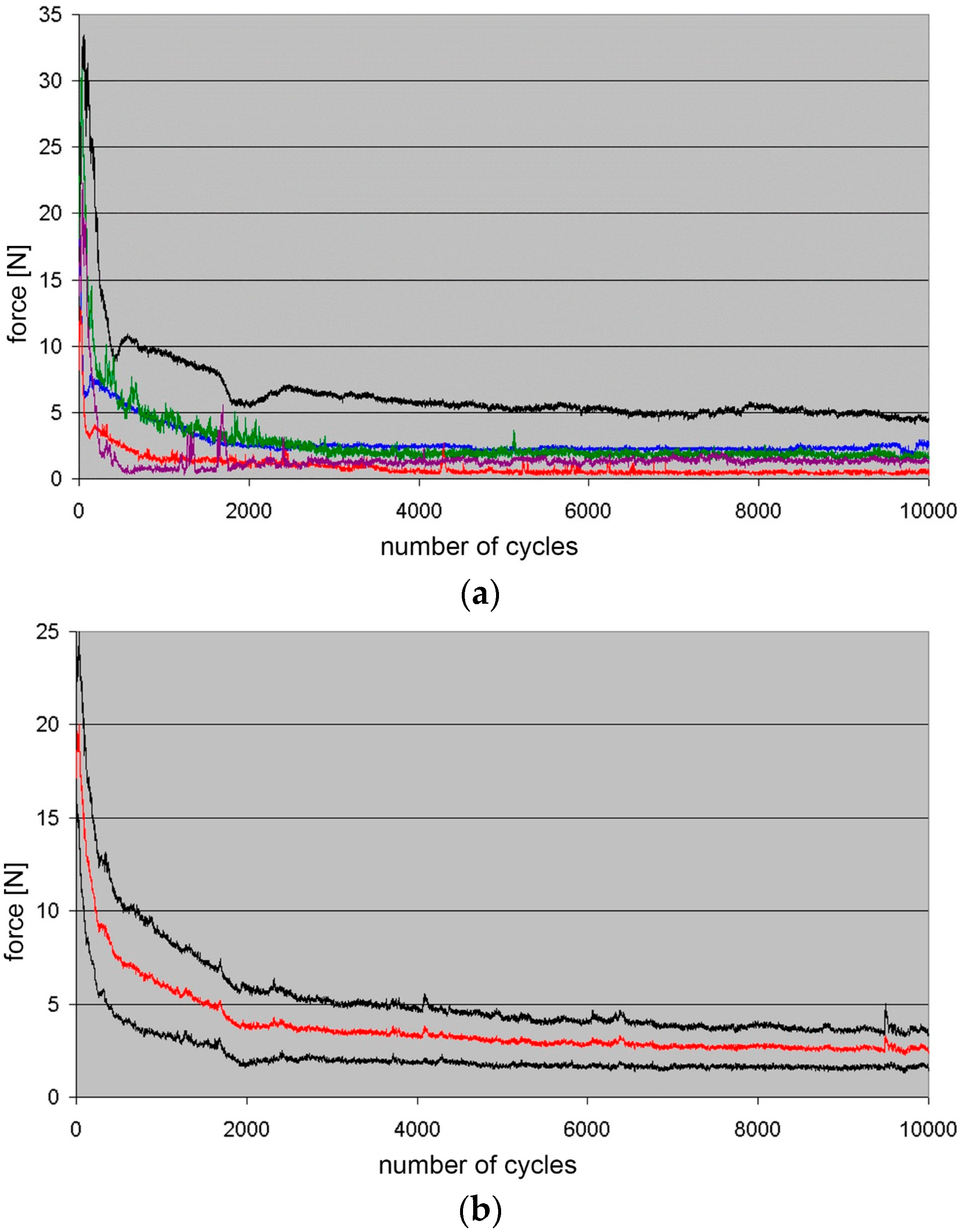
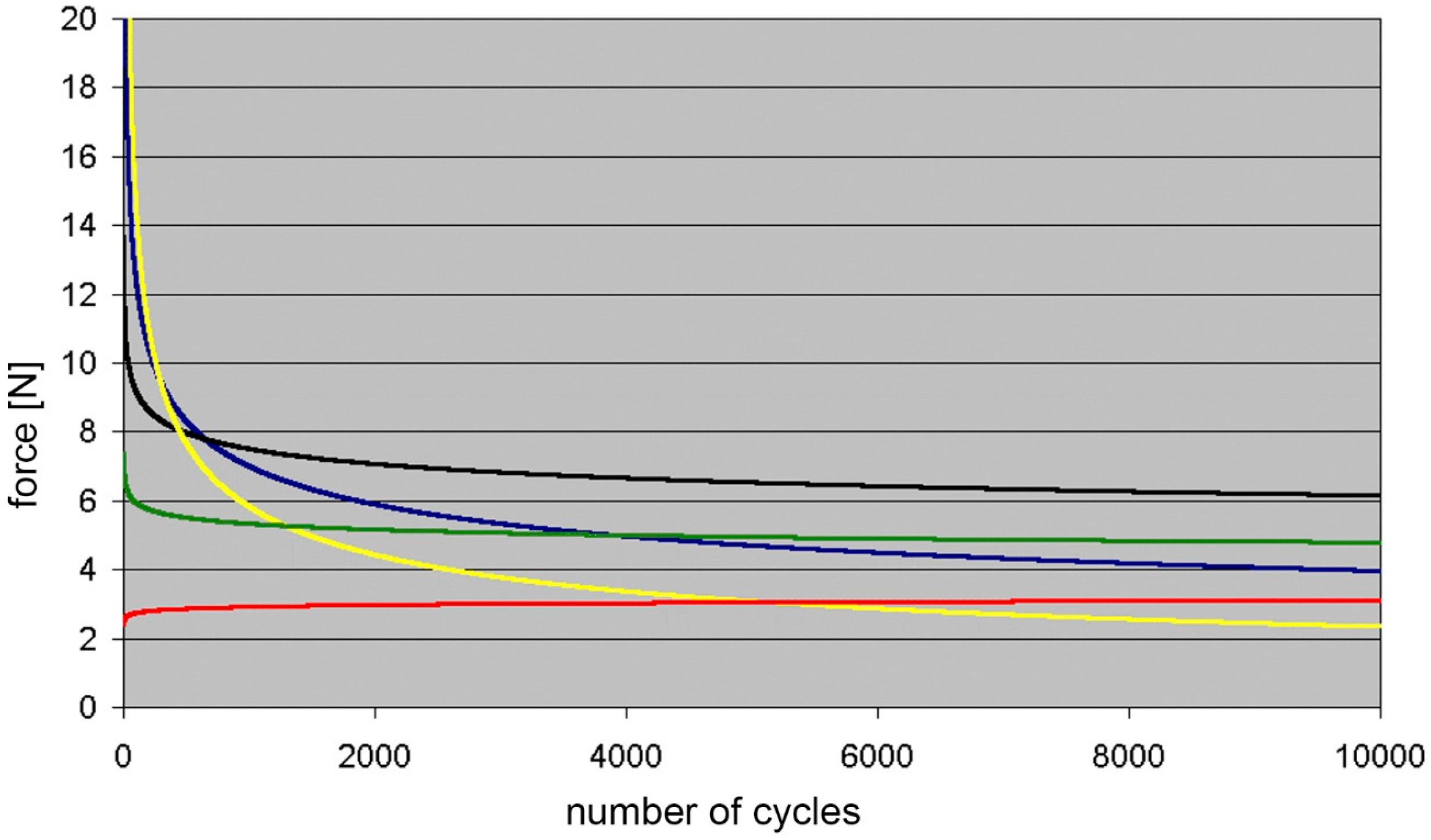

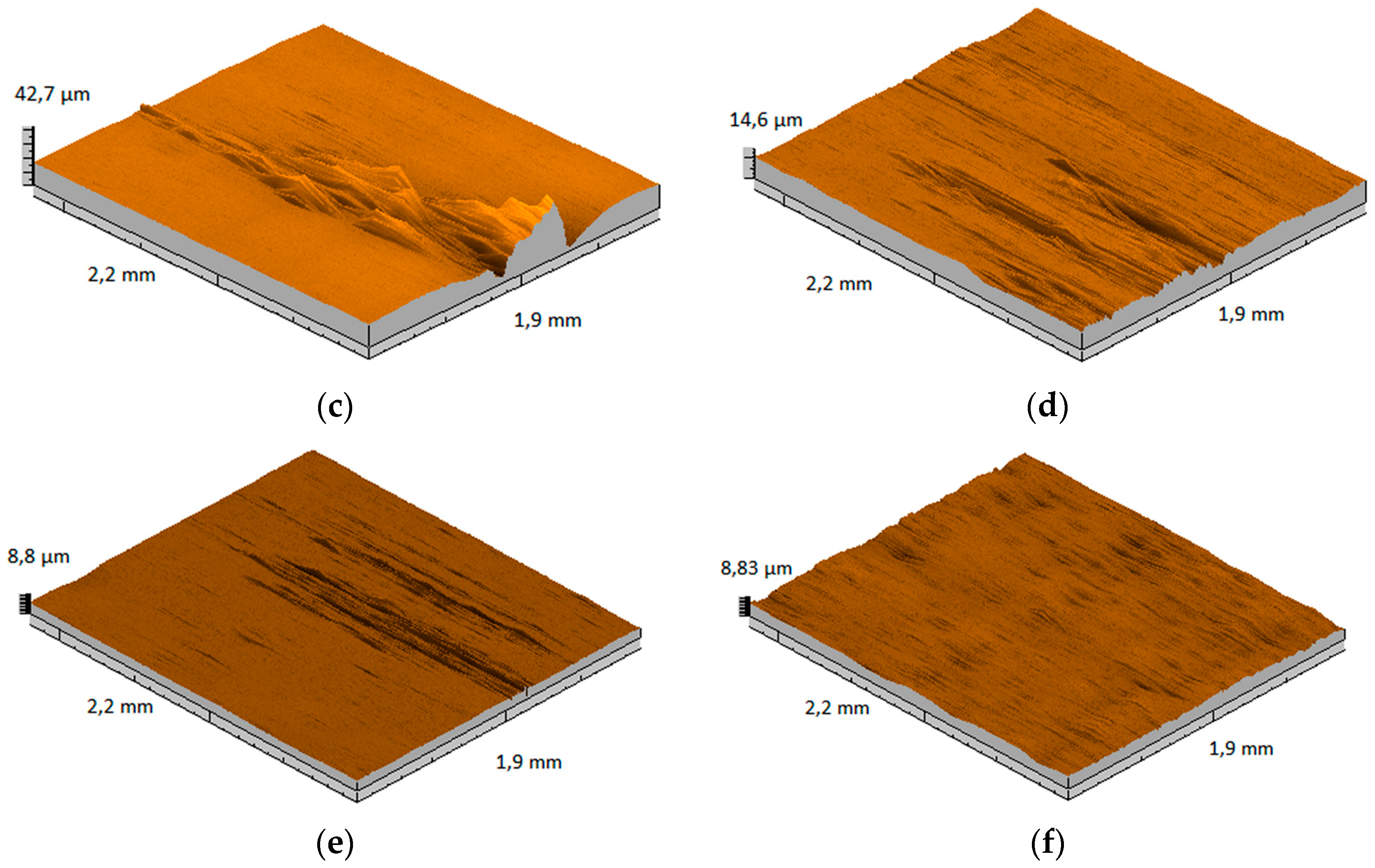
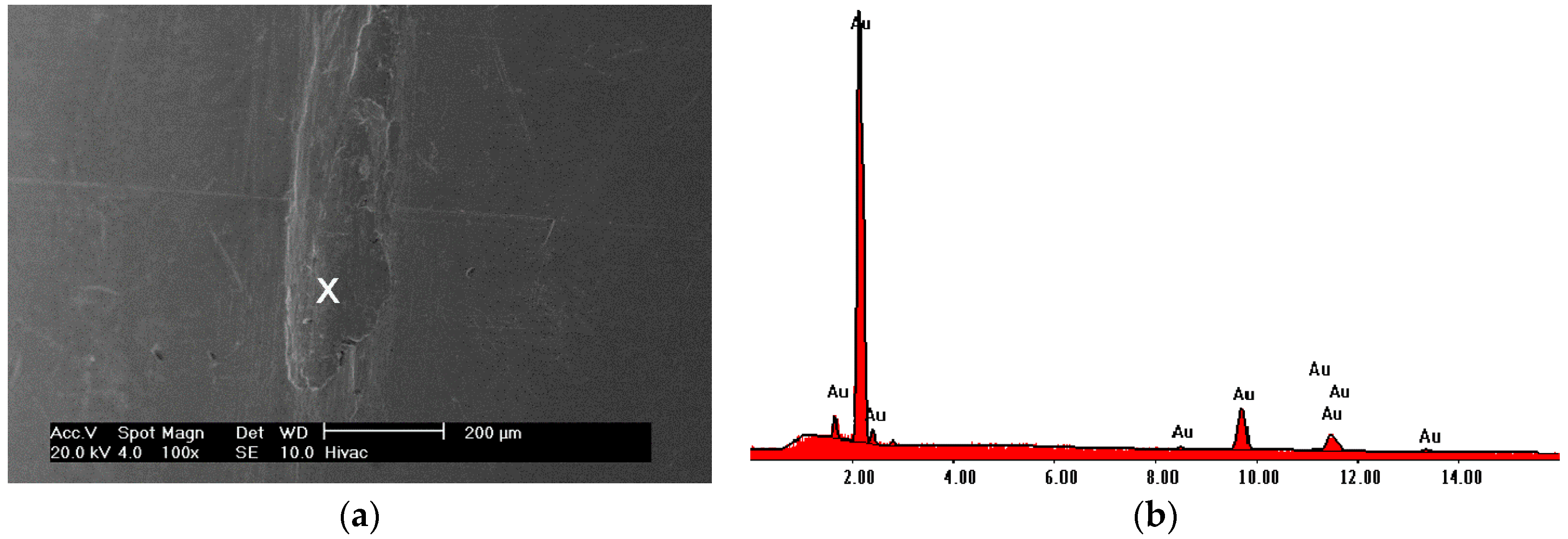
| Test Series | Material for | Material Combination of | ||
|---|---|---|---|---|
| Primary Crown Material/Material Group | Secondary Crown Material/Material Group | Similar/Identical Groups of Materials | Different Groups of Materials | |
| A | Degunorm®/high gold alloy | Degunorm®/high gold alloy (casted) | + | |
| B | Degunorm®/high gold alloy | Remanium 2000®/non-precious metal alloy | + | |
| C | Degunorm®/high gold alloy | AGC-Gold®/electroformed gold | + | |
| D | Rematitan®/titanium grade 1 | Rematitan®/titanium grade 1 (casted) | + | |
| E | Rematitan®/titanium grade 1 | AGC-Gold®/electroformed gold | + | |
| F | IPS Empress 2®/silicate ceramics | AGC-Gold®/electroformed gold | + | |
| Manufacturing Technologies | High Gold Alloy | Non-Precious Metal Alloy | Titanium | Ceramics | Electroformed Gold |
|---|---|---|---|---|---|
| alloy or ceramics/manufacturer | Degunorm/Degudent , Hanau, D (Au-73.8; Ag-9.2; Pt-9.0; Cu-4.4; Zn-2.0; In-1.5; Ir-0.1) | Remanium 2000/Dentaurum, Ispringen/Pforzheim, D (Co-61.0; Cr-25.0; Mo-7.0; W-5.0; Si-1.5; Mn- < 1.0; N- < 1.0) | Rematitan Typ 1/Dentaurum, Ispringen/Pforzheim, D (Ti- > 99.5; Fe-0.20; O-0.12; C-0.08; N-0.05; H-0.01) | IPS Empress 2/Ivoclar-Vivadent, Schaan, FL | AGC/Wieland, Pforzheim, D (Au ≥ 99.9; Cu ≤ 0.1) |
| investment material/manufacturer | Deguvest CF/Degudent, Hanau, D | Castorit Super C/Dentaurum, Ispringen/Pforzheim, D | Rematitan ultra/Dentaurum, Ispringen/Pforzheim, D | Star—Vest Soft II/Weber Dental, Lengwil, CH | - |
| casting machine or oven/manufacturer | Multicast compact/Degudent, Hanau, D | Castomat/Dentaurum, Ispringen/Pforzheim, D | Rematitan—Gießanlage/Dentaurum, Ispringen/Pforzheim, D | EP 500/Ivoclar-Vivadent, Schaan, FL | AGC-Mikro/Wieland, Pforzheim, D |
| manufacturing procedure | centrifugal casting | high frequency-centrifugal casting | vacuum pressure casting | pressed ceramic | electroforming |
| Series | Median | Mean Value | Standard Deviation |
|---|---|---|---|
| A | 1.22 | 1.23 | ±0.17 |
| B | 0.77 | 0.81 | ±0.20 |
| C | 0.96 | 0.98 | ±0.24 |
| D | 1.00 | 0.99 | ±0.20 |
| E | 0.65 | 0.66 | ±0.27 |
| F | 2.70 | 2.76 | ±0.87 |
| Series | Pull-off Forces at the Start of the Test | Pull-off Forces at the End of the Test | Tendency |
|---|---|---|---|
| Median/Mean Value ± Standard Deviation | |||
| A | 11.1/14.9 ± 12.8 | 3.3/4.0 ± 2.6 | −70% |
| B | 10.7/11.0 ± 1.9 | 5.9/6.5 ± 2.5 | −45% |
| C | 5.6/5.3 ± 1.8 | - | - |
| D | 18.2/18.6 ± 6.6 | 2.1/2.4 ± 1.5 | −88% |
| E | 5.9/6.1 ± 1.0 | 4.4/4.7 ± 1.5 | −25% |
| F | 3.1/3.4 ± 1.1 | 2.8/2.9 ± 0.8 | −10% |
| Series Comparison | Number of Test Cycles | |||||||||
|---|---|---|---|---|---|---|---|---|---|---|
| 1000 | 2000 | 3000 | 4000 | 5000 | 6000 | 7000 | 8000 | 9000 | 10,000 | |
| A/B | 0.880 ns. | 0.069 ns. | 0.290 ns. | 0.762 ns. | 0.650 ns. | 0.173 ns. | 0.112 ns. | 0.041 ns. | 0.082 ns. | 0.026 ns. |
| A/D | 0.151 ns. | 0.069 ns. | 0.028 ns. | 0.019 ns. | 0.019 ns. | 0.041 ns. | 0.028 ns. | 0.096 ns. | 0.041 ns. | 0.009 ns. |
| A/E | 0.545 ns. | 0.496 ns. | 0.880 ns. | 0.545 ns. | 0.762 ns. | 0.325 ns. | 0.405 ns. | 0.130 ns. | 0.290 ns. | 0.226 ns. |
| A/F | 0.028 ns. | 0.059 ns. | 0.041 ns. | 0.049 ns. | 0.112 ns. | 0.173 ns. | 0.151 ns. | 0.545 ns. | 0.650 ns. | 0.325 ns. |
| B/D | 0.069 ns. | 0.001 s. | 0.001 s. | 0.002 s. | 0.001 s. | 0.002 s. | 0.002 s. | 0.002 s. | 0.001 s. | 0.001 s. |
| B/E | 0.151 ns. | 0.198 ns. | 0.096 ns. | 0.290 ns. | 0.307 ns. | 0.405 ns. | 0.364 ns. | 0.290 ns. | 0.198 ns. | 0.041 ns. |
| B/F | 0.001 s. | 0.001 s. | 0.002 s. | 0.002 s. | 0.004 s. | 0.010 ns. | 0.004 s. | 0.004 s. | 0.010 ns. | 0.001 s. |
| D/E | 0.496 ns. | 0.001 s. | 0.008 ns. | 0.002 s. | 0.001 s. | 0.001 s. | 0.001 s. | 0.001 s. | 0.002 s. | 0.001 s. |
| D/F | 0.290 ns. | 0.325 ns. | 0.405 ns. | 0.449 ns. | 0.130 ns. | 0.173 ns. | 0.130 ns. | 0.151 ns. | 0.059 ns. | 0.034 ns. |
| E/F | 0.004 s. | 0.006 ns. | 0.006 ns. | 0.002 s. | 0.002 s. | 0.001 s. | 0.002 s. | 0.001 s. | 0.013 ns. | 0.001 s. |
| Series | Median | Mean Value | Standard Deviation |
|---|---|---|---|
| A | 11.50 | 11.79 | ±2.53 |
| B | 4.17 | 4.26 | ±1.50 |
| C | 19.80 | 22.93 | ±13.98 |
| D | 11.65 | 11.24 | ±2.49 |
| E | 3.19 | 6.61 | ±6.27 |
| F | 6.75 | 6.51 | ±2.02 |
| Series | A | B | C | D | E | F |
|---|---|---|---|---|---|---|
| A | <0.001 s. | 0.023 ns. | 0.571 ns. | 0.013 ns. | 0.001 s. | |
| B | 0.001 s. | <0.001 s. | 0.597 ns. | 0.019 ns. | ||
| C | 0.019 ns. | 0.002 s. | 0.004 ns. | |||
| D | 0.016 ns. | 0.002 s. | ||||
| E | 0.197 ns. | |||||
| F |
© 2016 by the authors; licensee MDPI, Basel, Switzerland. This article is an open access article distributed under the terms and conditions of the Creative Commons Attribution (CC-BY) license (http://creativecommons.org/licenses/by/4.0/).
Share and Cite
Linek, W.; Richter, G.; Raedel, M.; Walter, M.; Reitemeier, B. In Vitro Analysis of the Tribological Behaviour of Different Material Combinations for Telescopic Crowns. Metals 2016, 6, 149. https://doi.org/10.3390/met6070149
Linek W, Richter G, Raedel M, Walter M, Reitemeier B. In Vitro Analysis of the Tribological Behaviour of Different Material Combinations for Telescopic Crowns. Metals. 2016; 6(7):149. https://doi.org/10.3390/met6070149
Chicago/Turabian StyleLinek, Wigbert, Gert Richter, Michael Raedel, Michael Walter, and Bernd Reitemeier. 2016. "In Vitro Analysis of the Tribological Behaviour of Different Material Combinations for Telescopic Crowns" Metals 6, no. 7: 149. https://doi.org/10.3390/met6070149





